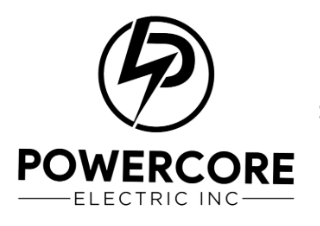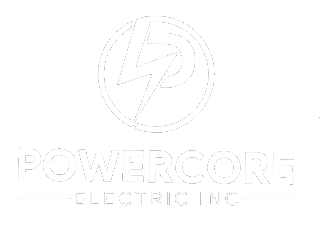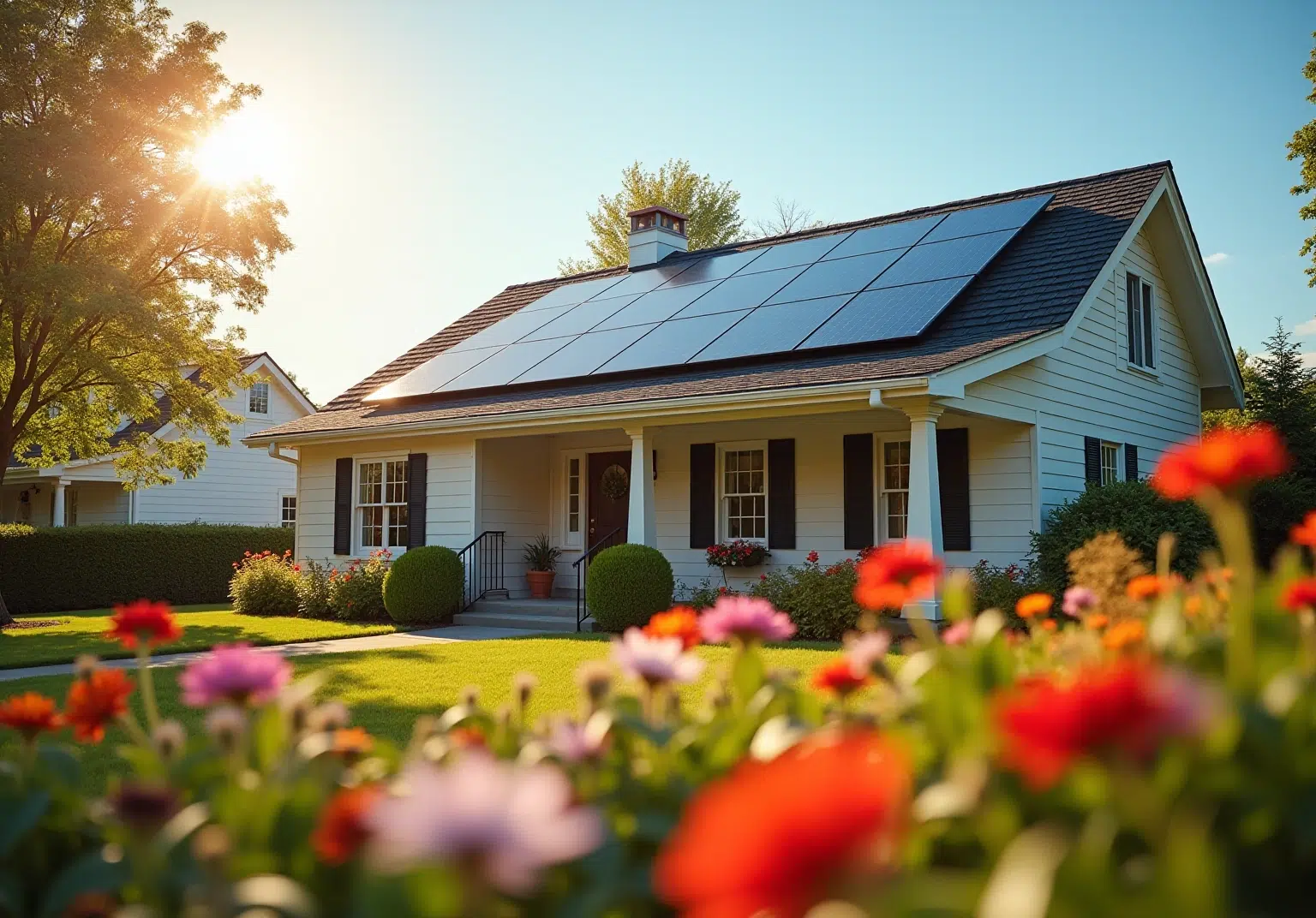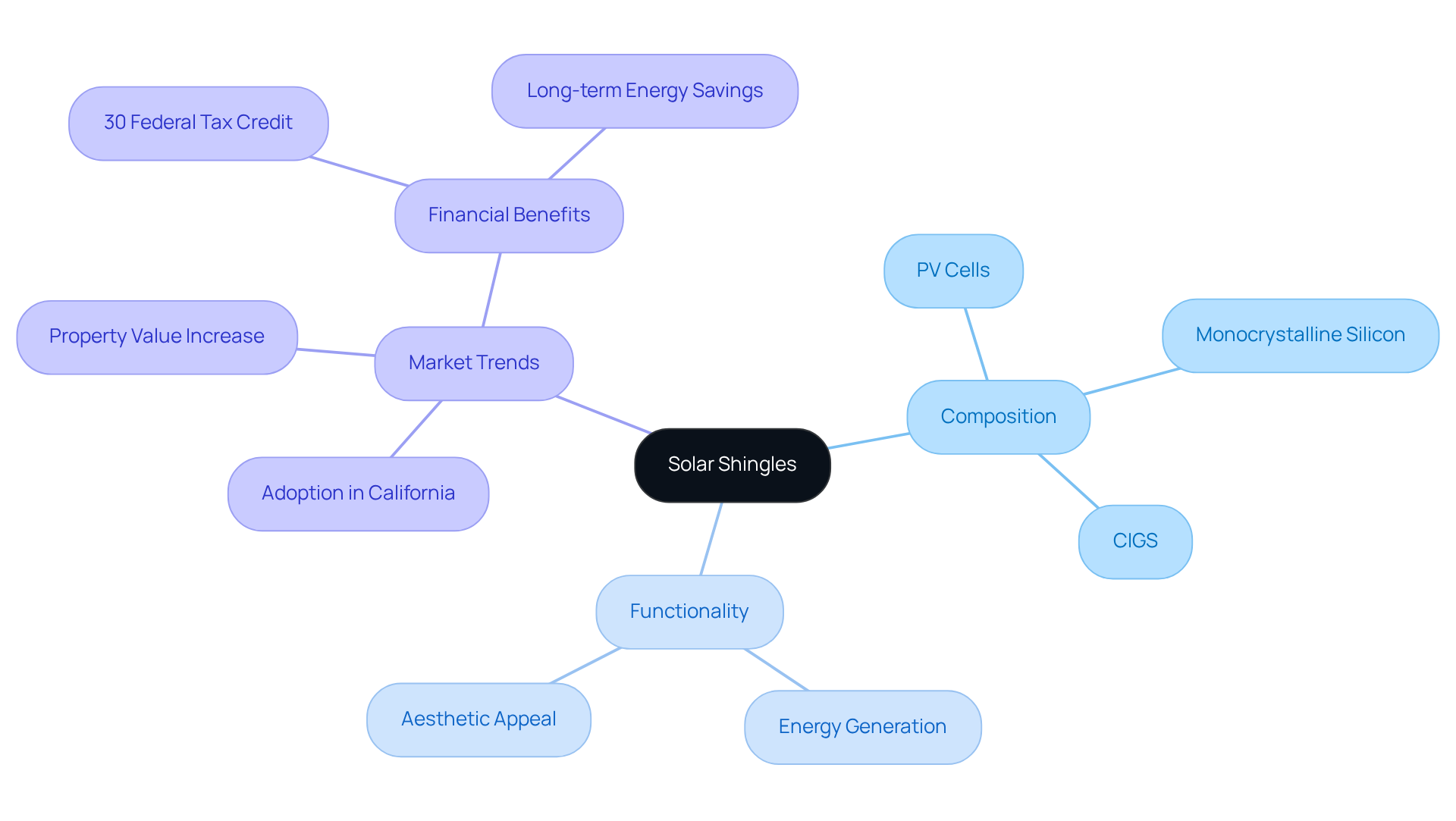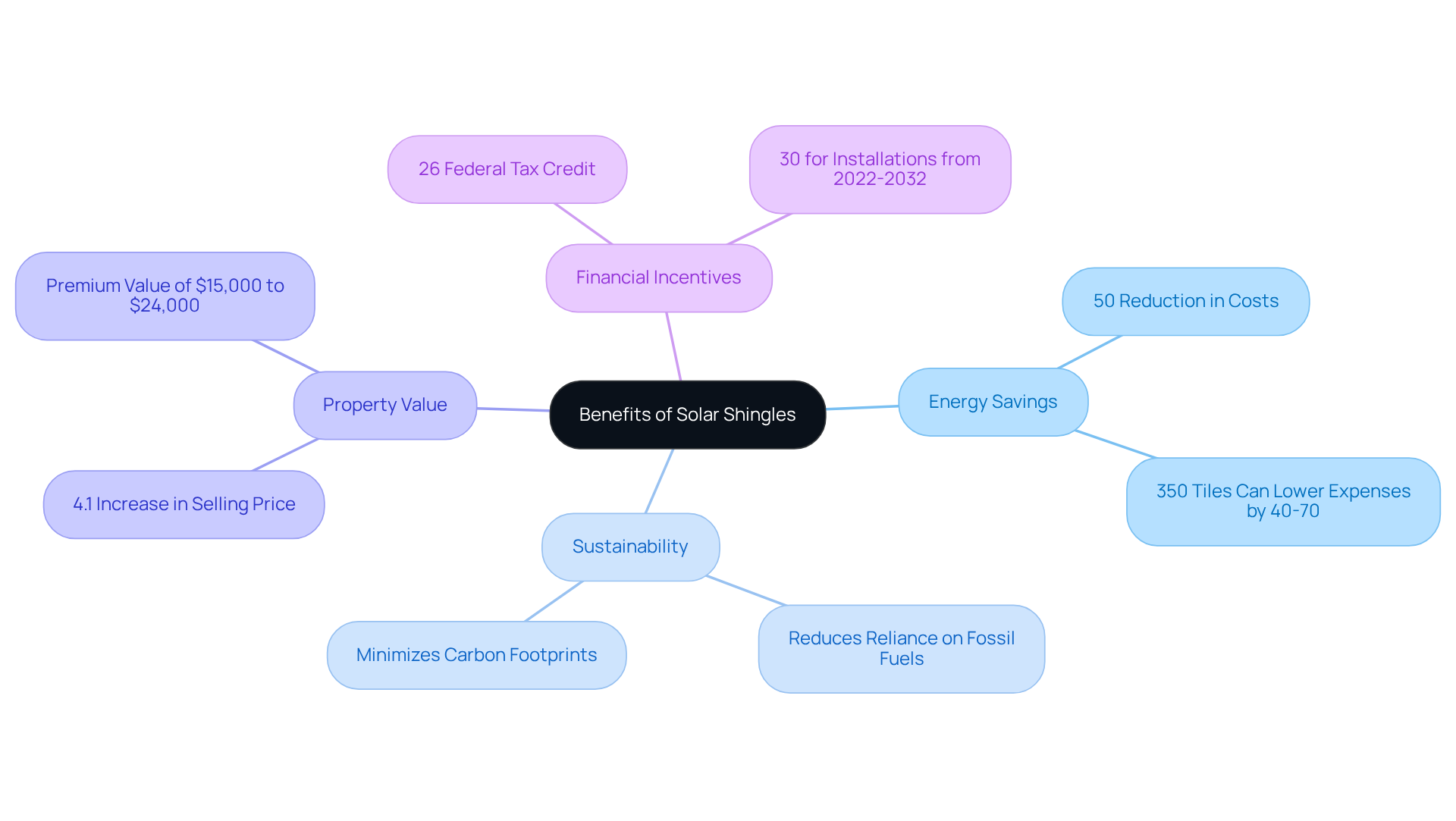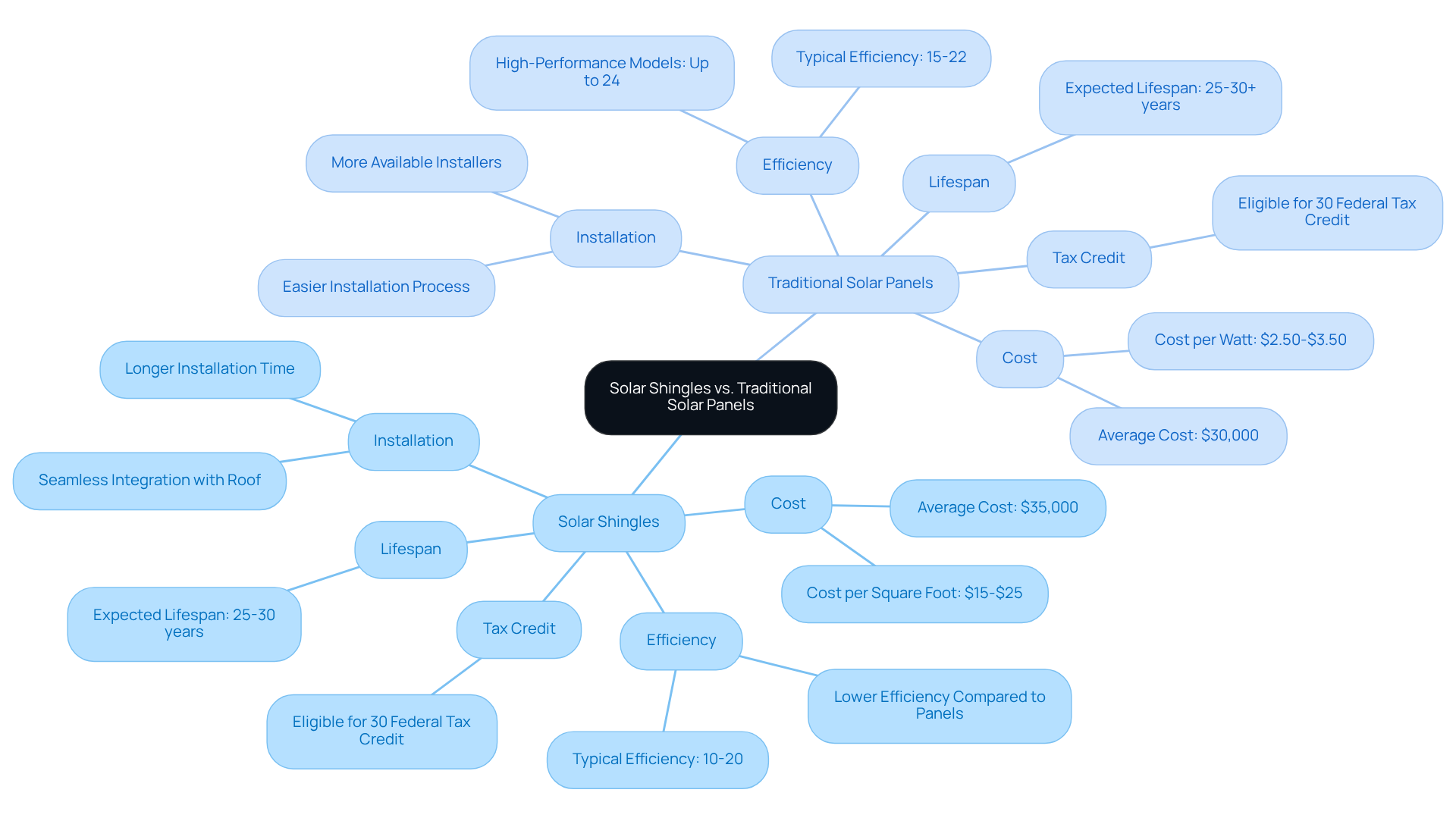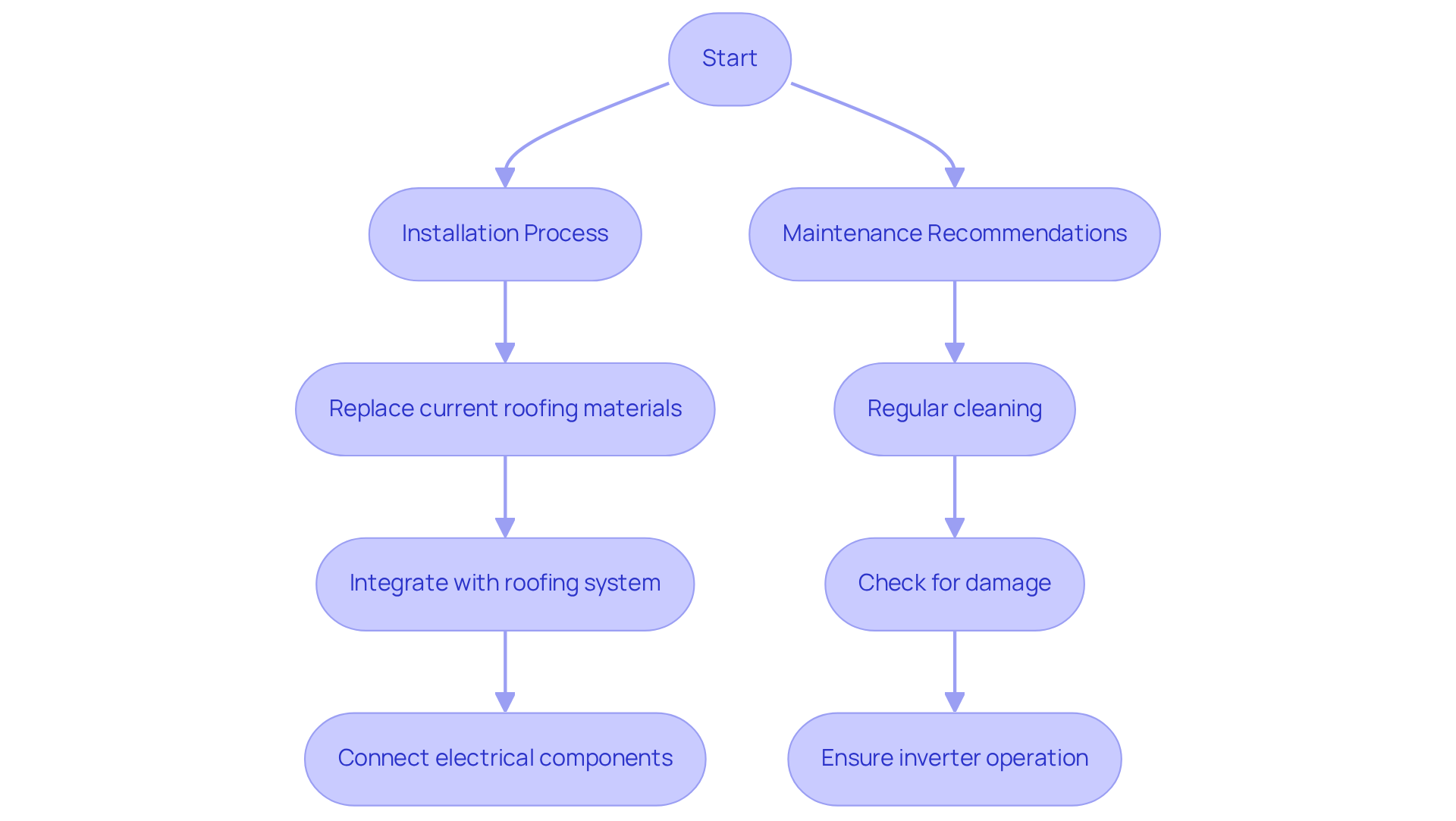Overview
Are you feeling overwhelmed by rising energy bills? You’re not alone. Many homeowners share this concern, and it’s completely understandable. Solar shingles present a wonderful opportunity to not only enhance the beauty of your home but also to take control of your energy costs. These innovative roofing materials combine the aesthetic appeal of traditional roofs with the remarkable functionality of generating electricity through photovoltaic cells.
Imagine the significant energy savings you could enjoy while also increasing your property value. Beyond that, there are tax credits available that make this investment even more enticing. It’s a step towards energy independence that many eco-conscious homeowners are embracing.
Together, we can explore how solar shingles can transform your home into a sustainable energy solution. Let’s work towards a future where your energy habits align with your values. If you’re ready to learn more about how solar shingles can benefit you, please reach out. We’re here to support you every step of the way.
Introduction
As homeowners face the challenge of rising energy costs, innovative solutions like solar shingles shine brightly as a source of hope. These advanced roofing materials not only enhance the beauty of homes but also capture solar energy to generate electricity, providing a sustainable alternative to conventional roofing options.
It’s common to wonder, how do solar shingles compare to traditional solar panels? By exploring the functionality, benefits, and long-term implications of solar shingles, we can uncover a compelling case for homeowners who seek both energy savings and a commitment to environmental responsibility.
Together, we can navigate this journey towards a more sustainable future.
Define Solar Shingles: Composition and Functionality
Are you feeling overwhelmed by rising energy bills? You’re not alone in this concern, and it’s completely understandable to seek solutions that not only ease your financial burden but also contribute positively to the environment. Solar shingles, or photovoltaic panels, are here to help. These advanced roofing materials beautifully mimic the look of traditional roofing while harnessing the sun’s energy to generate electricity.
Made primarily from photovoltaic (PV) cells, often crafted from materials like monocrystalline silicon or copper indium gallium selenide (CIGS), these innovative tiles serve a dual purpose. They protect your home from the elements and transform sunlight into usable electricity. Imagine enjoying the aesthetic appeal of your roof while knowing it is working hard to provide sustainable energy for your household.
As we look towards 2025, the trend in California is clear: more and more homeowners are integrating solar shingles into their residences. This shift not only reflects a growing commitment to sustainable energy practices but also enhances property value, making your home even more appealing, especially in neighborhoods with strict design regulations. It’s common to feel hesitant about such an investment, but consider the long-term benefits.
Experts in the roofing sector highlight the significant advantages of solar shingles, emphasizing their ability to save on energy costs. While the initial investment in solar shingles may be higher than that of conventional photovoltaic panels, the lasting benefits—lower energy bills and increased property value—make these tiles a wise choice for environmentally conscious homeowners. Plus, with a 30% federal tax credit available under the Residential Clean Energy Credit, the financial appeal of this investment becomes even more compelling.
Together, we can explore how can transform your home into a sustainable haven. If you’re ready to take a step towards energy independence while enhancing your home’s beauty, reach out today. We are here to guide you every step of the way, ensuring you feel supported in your journey towards a more sustainable future.
Explore the Benefits of Solar Shingles: Energy Savings and Sustainability
We understand that managing electricity bills can be a significant concern for homeowners. The advantages of solar shingles are extensive and can lead to substantial reductions in these costs. By harnessing sunlight to generate power, homeowners can offset their energy consumption significantly. For instance, photovoltaic tiles can reduce monthly electricity costs by about 50%, resulting in savings of roughly $150 for certain households. Imagine the relief of seeing a lower utility bill! Furthermore, installing 350 photovoltaic tiles can lower typical utility expenses by 40 to 70 percent, offering a broader perspective on potential savings. These solar shingles not only help with your finances but also play a crucial role in promoting sustainability by decreasing reliance on fossil fuels and minimizing carbon footprints—an increasingly vital consideration in today’s eco-conscious landscape.
Additionally, residences outfitted with renewable energy technology often experience a rise in property value, making them more attractive to eco-conscious purchasers. Research indicates that properties with renewable energy systems can sell for an average of 4.1% more than similar homes without such features. This premium can vary from $15,000 to $24,000 for a $30,000 roof installation, enhancing the financial appeal of these investments.
Homeowners can also benefit from various tax credits and incentives. For example, federal tax credits can reduce installation costs by up to 26%, with this credit increasing to 30% for systems installed between 2022 and 2032. The sleek design of solar shingles allows them to blend effortlessly with traditional roofing materials, providing a visually appealing option compared to standard panels. Moreover, these tiles require minimal upkeep, involving only routine evaluations and cleaning, which further assures property owners about the practicality of this investment. Together, the combination of , sustainability advantages, and enhanced property value makes photovoltaic roofing a compelling option for homeowners seeking to invest in renewable energy solutions. Let’s work towards a greener future together!
Comparative Analysis: Solar Shingles vs. Traditional Solar Panels
When it comes to addressing your concerns about energy bills, considering solar shingles as an alternative to traditional panels can be a significant step towards energy independence. Traditional photovoltaic panels typically boast efficiency rates between 15% and 22%, with some high-performance models reaching up to 24%. In contrast, photovoltaic tiles generally achieve efficiencies between 10% and 20%. This difference means that you may need a larger quantity of roof tiles to generate the same energy output as a smaller array of photovoltaic panels.
We understand that the installation process is a crucial factor for many homeowners. Solar shingles can provide a more seamless integration, as they are designed to fit directly into your roofing system, eliminating the need for separate mounting structures. However, it’s important to note that the typical expense for photovoltaic roofing tiles is around $35,000, which is considerably higher than the average price of a conventional panel system, roughly $30,000.
Both photovoltaic roof tiles and panels have a lifespan of 25 to 30 years, making them a long-term investment in your home. Additionally, if you choose to install photovoltaic tiles, you may qualify for a 30% tax credit through the Residential Clean Energy Credit (RCEC), which can significantly reduce your upfront expenses.
Ultimately, the choice between photovoltaic tiles and panels depends on your personal preferences regarding aesthetics, budget considerations, and specific energy needs. While photovoltaic tiles provide a more that integrates beautifully with your roof, conventional panels often deliver greater efficiency and lower initial costs, making them a more practical choice for many homeowners. Together, we can explore the best options for your unique situation, ensuring you feel supported every step of the way.
Installation and Maintenance Considerations for Solar Shingles
We understand that managing energy bills can be a significant concern for homeowners. Installing solar shingles not only addresses this issue but also provides a sustainable solution that can transform your roof into a source of energy. This process typically involves replacing current roofing materials with photovoltaic tiles, which can be done during a roof replacement or as a new installation. Skilled professionals are essential to ensure that the tiles integrate seamlessly with your roofing system and electrical connections, providing you with peace of mind.
Maintenance for these innovative tiles is generally low, as they are designed to withstand various weather conditions. However, we recommend routine inspections to keep your roofing clear of debris and to ensure that all electrical components are functioning properly. Homeowners can take comfort in knowing that warranties may extend up to 25 years, along with service agreements that could cover repairs or replacements, ensuring long-term reliability and performance.
Looking ahead to 2025, you can expect advancements in maintenance techniques for solar panels, focusing on efficiency and simplicity. Typical upkeep methods include:
- Regularly cleaning the roof covering to remove dirt and debris
- Checking for any signs of damage
- Ensuring that the inverter is operating correctly
While maintenance costs are usually low, planning for periodic inspections and potential repairs is wise to maximize the lifespan of your roofing materials, which can last between 20 to 30 years.
Furthermore, it’s essential to evaluate the financial implications of your investment. The average payback period for photovoltaic roof tiles ranges from 5 to 15 years. By following these maintenance tips and considering their potential impact on your home’s value, you can ensure that your solar shingles perform effectively, which contributes to energy savings and sustainability. Together, let’s work towards a greener future and greater for your home.
Conclusion
We understand that rising energy bills can be a significant concern for homeowners. Solar shingles provide a transformative approach to energy generation, seamlessly integrating sustainability with aesthetic appeal. These innovative roofing materials not only shield your home from the elements but also convert sunlight into electricity, offering you a dual benefit that traditional roofing options simply cannot match. As the trend towards renewable energy continues to grow, solar shingles emerge as a compelling solution for those looking to reduce energy costs while enhancing their property’s value.
Imagine the significant energy savings you could experience—up to 70% reduction in electricity bills, combined with the added financial incentive of federal tax credits. This makes the case for investing in solar shingles even more persuasive. Furthermore, their low-profile design allows for a visually appealing integration with traditional roofing, ensuring that your home remains attractive while being energy-efficient.
Ultimately, the shift towards solar shingles is not just about energy savings; it embodies a commitment to a more sustainable future. By choosing solar shingles, you can contribute to reducing reliance on fossil fuels while enjoying the long-term financial benefits of renewable energy. Together, we can enhance individual homes and contribute to a collective movement towards a greener, more energy-independent society. Taking the first step towards this sustainable journey can lead to significant rewards—both for the environment and for your personal finances. Let’s work towards a brighter, more sustainable future together.
